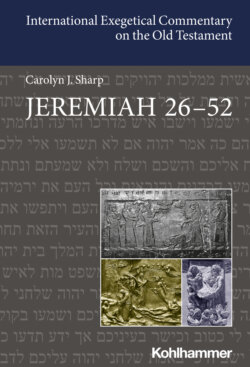Читать книгу Jeremiah 26-52 - Carolyn Sharp - Страница 18
На сайте Литреса книга снята с продажи.
Structural Signs of Textual Resilience
ОглавлениеWithin the prose in Jer 26–52, two structural features showcase the impressive skill of the scribes who worked to render the Jeremiah traditions as textually resilient. These ancient stories and poems are capable of being restored and amplified by the scribes for new historical contexts in the unfolding life of the covenant people. The enduring prophetic word First, and to be explored in depth in Jer 36, is the framing of the written prophetic word as enduring and resistant to erasure. Scrolls—plural—have been written (25:13; 29:1; 30:2; 36:2, 4; 45:1). But these witnesses to covenantal fidelity are at continual risk, due to the violent actions of Jeremiah’s local antagonists (20:1–2; 26:8–9; 37:11–16; 38:4–6) and due to imperial malfeasance in the person of Jehoiakim, who takes a scribe’s razor to the holy word while his officials watch, complicit in the outrage (36:22–24). The word of Yhwh spoken by Jeremiah and written by Baruch is, however, stronger than every assault launched at them. Jeremiah the prophet and Baruch the scribe persist, yielding an enduring prophetic witness that exceeds all that had been spoken before (36:32) and that will triumph over even the strongest enemy (51:60–64).
Doubling A second structural feature involves narratological and discursive doubling. Interpreters have noticed that several events and semantic formulations occur twice in Jer 26–52.77 At the level of plot, doubled events advance characterization and action in suspenseful and interesting ways. Within poetic oracles, doubled discourse weaves disparate contexts together to demonstrate that the divine plan is indeed unfolding as Yhwh wills, despite apparent evidence to the contrary in any moment when the purposes of Yhwh might seem occluded. Scholars reflecting on this phenomenon according to historicist methodological assumptions speculate that a real historical event is refracted in two different ways in the narratives. That cannot be proved, of course, and I find it best to explore this phenomenon as a dimension of scribal literary art. Semantic similarities between Jeremiah’s undated oracle in 7:1–15 in the temple gate (שׁער) and his oracle in 26:1–6 in the temple court (חצר), dated to the beginning of Jehoiakim’s reign, have prompted many to see the oracle in ch. 26 as a second refraction of what had been a single event. The weak Zedekiah sends representatives to consult Jeremiah twice (37:3–10, 17–21; 38:14–28), the stakes being heightened for the prophet himself and for Judah as time passes. Jeremiah is incarcerated twice (37:15–16; 38:6–13), or two times two, if we count as a second doubling his being remanded twice to the court of the guard after being released from other locations (37:21 and 38:13). The giving of an oracle of hope to Jeremiah’s ally Ebed-melech (39:15–18) is doubled by the giving of the same near-verbatim oracle of hope to Jeremiah’s ally Baruch (45:1–5), narrated as having happened years earlier and thus showing that the rhetorical logic of this storytelling is not limited to a linear unfolding according to diachronic time. Twice, a scroll of Jeremiah’s prophecies is destroyed or imagined as being destroyed (36:22–25 and 51:59–64). The fall of Jerusalem to the Babylonians is narrated in spare fashion in 39:1–8 and with considerably more detail and broader historical framing in Jer 52.
Doubling within poetic oracles is noteworthy particularly as regards oracles of judgment originally directed against Judah and then re-articulated against Judah’s enemies in the OAN (e.g., 6:22–24 against Daughter Zion and 50:41–43 against Daughter Babylon). This reduplication praxis yields an overarching texture of fated reversal and ironic comeuppance for the foes of Yhwh’s people, as interpreters have noticed for centuries. Brief oracles of promise concerning the Davidic dynasty are repeated (e.g., 23:5–6 and 33:15–16), as are restoration notices to some of Judah’s enemies (48:47; 49:6, 39; cf. 46:26). Also recurring are threatening phrases about the terrors of sword, famine, and pestilence stalking the land. These horrors are mentioned sometimes in pairs and sometimes in the complete triad, in the voices of various speakers, sometimes with narrative elaboration and sometimes in a syntagmatic list (5:12; 11:22; 14:12–18; 15:2; 16:4; 18:21; 21:7–9; 24:10; and passim in chs. 27, 29, 32, 34, 38, 42, and 44). Many rich local effects are achieved by this “seconding” technique in particular textual sites. As a perceptible overarching feature of the Jeremiah traditions, narratological and discursive doubling may be taken to suggest a resilience and capaciousness of the word of Yhwh for the ongoing life of the covenant people, available for remembrance and reinterpretation in every circumstance in which Judeans may find themselves.
